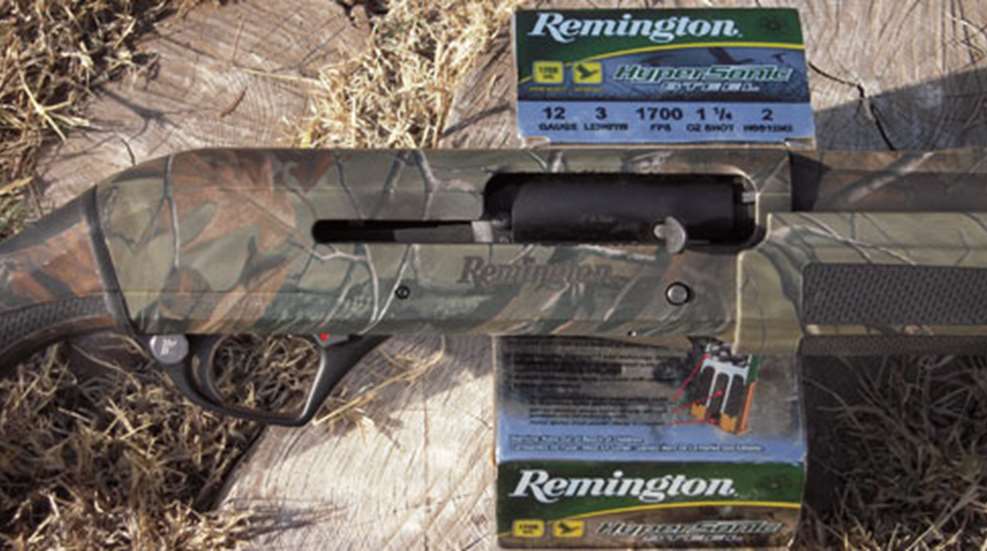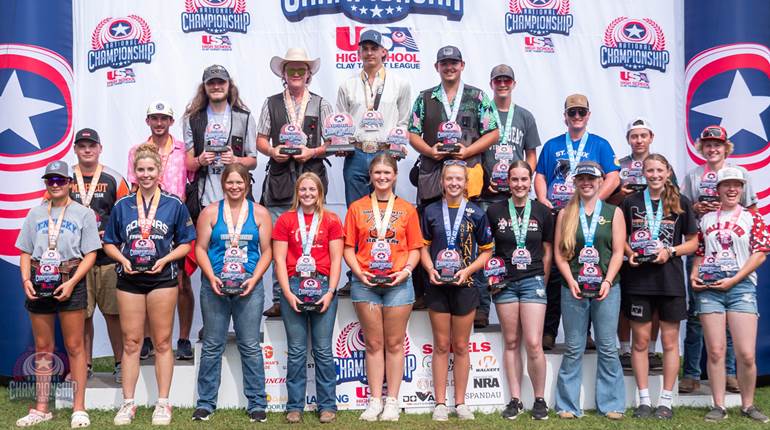
Hunting in Argentina, where you can fire from 500 to 1,000 shotshells per day, is a great way to wring out any shotgun. So, when the folks from Remington called with an invitation for me to join them there to try the company’s new VersaMax shotgun, they sure didn’t have to ask me twice. Bird hunting in Argentina’s San Luis province with Sier Safaris turned out to be great fun. And it gave me a chance to get up-close and personal with this latest scattergun from Remington.
The VersaMax is a gas-operated, 12-gauge autoloading shotgun designed to provide today’s hunter with uncommon versatility. It accommodates 2 3/4-, 3-, and 3 1/2-inch shells and will do so without any adjustment to the gun.
Remington accomplishes this by means of its VersaPort gas piston system, which uses seven gas ports in the area of the chamber and two self-cleaning gas pistons to cycle the action. The length of the chambered shell determines how many of the ports are operational at any given time. The shortest shell, the 2 3/4 inch, exposes all seven ports and allows escaping gas to cycle the action in spite of the fact that the 2 3/4-inch shotshell produces the least amount of energy. When a 3-inch shell is chambered, four gas ports are left uncovered. And with the 3 1/2-inch shell only three ports are exposed to provide the gas for reliable function in the shotgun. For that reason, you can load any of the three shell lengths into the VersaMax’s magazine in any given order and the action will cycle them, bleeding off just enough gas from each to handle that particular length and power level.
Right in line with the design of the VersaMax gas system was Remington’s desire for the gun to have soft recoil for more pleasant shooting, quicker target acquisition, and more comfort for the shooter. Remington folks tell me that their testing indicates that the VersaMax is the softest shooting autoloading shotgun in its class. And, although felt recoil is subjective, I have to say that I found the shotgun very comfortable to shoot.
Remington also designed the VersaMax so that it could be taken down into five major parts. And best of all, this can be done without tools. In order to disassemble the bolt, there are only a couple of pins that have to be pushed out. Waterfowl hunters know that this is not just a marketing ploy because shotguns can get awfully wet during a good day in the duck marshes. Once back at the lodge, it takes only moments to break this shotgun down for a thorough cleaning and lubrication.
To further protect the VersaMax shotgun for long life, all internal parts are nickel-Teflon coated. The barrel is TriNyte coated, and the aluminum receiver is anodized. That keeps it out of the shop and in the field, where all good shotguns belong.
The VersaMax is currently being shipped with a 28-inch barrel featuring a ventilated rib, with the 26-inch version to come in January. The barrel features an extended forcing cone for more uniform patterns and a replaceable Hi-Viz front sight. ProBore screw-in choke tubes are standard-issue with this shotgun. I have to say, however, that the choke installation tool is too small and flimsy, just like those shipped with most of today’s shotguns. A guy wearing heavy gloves in a duck blind is going to have a time trying to quickly switch out his chokes. Remington should, and probably will, give some thought to solving this problem.
The VersaMax comes with a synthetic stock in three different color designs. The first is a black synthetic with gray panels in the pistol grip area and along the fore-end. The second is Mossy Oak Duck Blind Camo with black panels. And the third, available in January, is in Realtree AP-HD, also with black panels. All three stock designs feature a soft rubber insert at the top of the pistol grip that cushions the shooting hand.
Interestingly enough, the VersaMax stocks all feature a replaceable comb. Three different combs, in various sizes, come with each gun. The combs can be easily and quickly removed and installed by hand. Prior to hunting with the VersaMax, all one has to do is just spend a little time on the clays range, shooting with each comb installed, until he finds the one that best suits him. But the VersaMax stock innovations don’t stop there.
When the comb is removed, a compartment in the buttstock is exposed. Attached in that compartment is a nifty little plate that controls the amount of the stock’s drop and cast. The VersaMax owner’s manual describes how to position the plate in order to set the amount of drop or to adjust the stock for right- or left-handed shooters.
Most American shotgunners don’t know much about stock cast, since most American shotguns have a straight stock. But proper stock cast, cast-off for right-handed shooters and cast-on for lefties, will allow the shooter to be looking right down the top of the receiver when the gun butt hits the shoulder pocket.
The VersaMax buttstock is fitted with a black SuperCell recoil pad. In addition to that, each gun comes with three stock shims that can be installed to make the length-of-pull fit the individual shooter. Included are two quarter-inch shims and one half-inch shim. So length of pull can be adjusted from 14¼ inches out to 15¼ inches.
All three of these stock adjustment features (replaceable combs, drop/cast plate, and stock shims) come standard with the VersaMax. In addition to fitting the gun to the individual shooter, these features also allow the hunter to adjust his gun for the type of hunting he will be doing. Obviously, stock fit might need to be different when dove hunting in a T-shirt as opposed to sitting in a duck blind wearing all of the clothes from one’s closet.
Fielding The VersaMax
My test gun was the 28-inch, 12 gauge with the black stock and gray panels. It weighed 7 pounds, 9 ounces and balanced very nicely, came to the shoulder smoothly and looked sharp. Still, good-looking guns are one thing but it has always been good-shooting guns that interested me. And I figured that this Argentine trip should tell me which one the VersaMax is.
July is winter in Argentina. This climatic fact was driven home to me when it snowed on us the whole first day of our hunt. We had set up right next to a woods, with an open pasture at our backs. The dove and pigeons came over the woods, at tree-top height, headed for the open country. And they sure didn’t seem to be bothered by that falling white stuff.
The Argentine dove is about the size of our white-wing dove of South Texas; however, they are colored more like the mourning dove. And the pigeons looked for all the world like the common rock pigeon that we find in the United States. It’s just that in Argentina there are lots more of both. To say the sky was blackened with birds is a gross exaggeration. I will say that at any given time you could look in the sky and see birds and somebody was getting a shot. The short of it is that Argentina has a very healthy dove and pigeon population.
Prior to the day’s shooting, I installed the improved cylinder choke in my VersaMax. This turned out to be a good choice as the shots could easily be taken at 25 to 30 yards. Also, being somewhat of a seasoned dove hunter, I knew that these birds weren’t all that hard to kill. They were just hard to hit. Pretty soon the sky was full of diving, darting and falling dove and pigeon. Birds and empty shotshells were soon stacking up. These days of hunting were spent near San Luis, in Argentina’s San Luis province. About half way through our hunt, we loaded up and drove down to a hunting lodge near Mercedes, also in San Luis province, near the Patagonian border. The several lakes on the property teemed with ducks and the pastures were alive with perdiz, Argentina’s upland bird.
For duck hunting we were provided with the new Remington HyperSonic 12-gauge, 3-inch shotshells, using the new Xelerator wads. These amazing new shotshells drive loads of No. 2 shot at 1,700 fps. That’s right, 1,700 fps. Surprisingly, though, the recoil of these shotshells was not that punishing when fired in the VersaMax shotgun. In no time at all, quite a few ducks were added to our overall game bag.
In the afternoons, we adjourned to the pastures around the lodge and hunted perdiz. There are about five species of this Argentine upland bird—the smallest being about the size of a chukar and the largest being almost as big as a prairie chicken. As with most upland birds, these have white meat. Remington’s VersaMax shotgun is all about versatility. And our Argentine hunt, taking a mixed bag of dove, pigeon, ducks and perdiz, proved that the shotgun has plenty of versatility. As I mentioned, I found that the VersaMax balanced very well, did not seem too heavy and (most importantly) shot where I looked.
The best thing that can be said about Argentine shotgun shells is that there were plenty of them. Whichever propellant they use happens to be just about the dirtiest burning I’ve ever seen. And frankly, we had a few malfunctions with the VersaMax, all of which I lay at the feet of those abominable South American shotshells. During its testing of this shotgun, using American ammunition, Remington fired hundreds of thousands of rounds through the guns.
Whether you are an upland hunter, a waterfowler, or a turkey hunter, the new Remington VersaMax is worth taking a look at. It’s an impressive shotgun.
Manufacturer: Remington Arms Co.; (800) 243-9700; www.remington.com
Action: gas-operated, semi-automatic shotgun
Gauge: 12, 23⁄4", 3" or 31⁄2"
Magazine Capacity: three (23⁄4" & 3"), two (31⁄2")
Barrel Length: 28” (tested), 26"
Overall Length: 4915⁄16"
Stock: Synthetic (black or Waterfowl Camo): length of pull, adjustable, 141⁄4 -151⁄4"; drop at comb, adjustable, 1½"; drop at heel, adjustable, 2"
Cast: adjustable
Weight: 7 lbs., 9 ozs.
Receiver: aluminum
Trigger: single-stage; 4 lbs., 2 ozs.
Chokes: five ProBore interchangeable screw-in chokes
Sights: tapered target style rib, Hi-Viz bead
Suggested Retail Price: $1,399 (synthetic); $1,599 (waterfowl model)





































